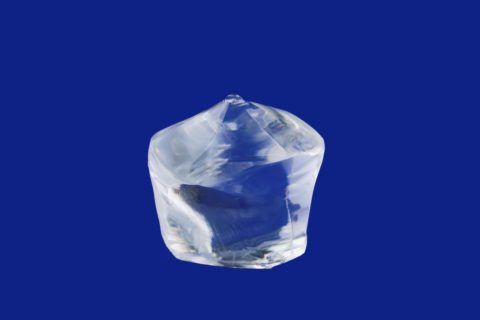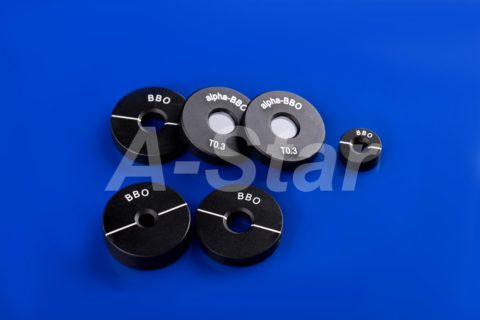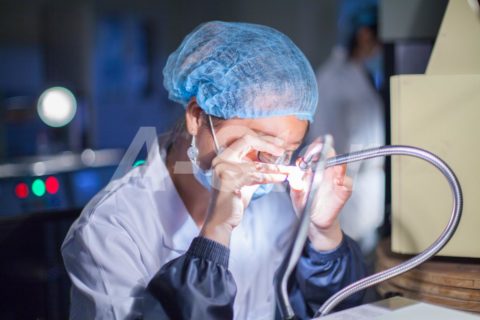
BBO crystal is a nonlinear optical crystal with a combination of the number of unique features.
A-Star Photonics is the original BBO crystals manufacturer who guaranteed 10 days of rapid delivery for most dimensions.
Custom BBO Crystal according to your specification.
For the latest BBO Crystal prices please email us!
Contact: sales@astarphotonics.com
Welcome to our factory inspection.
A-Star's BBO Crystals - Unparalleled Quality and Precision
A-Star Photonics: Your Premier Manufacturer of BBO Crystals in Fuzhou, China - Innovating Laser Applications with Precision and Excellence.
A-Star produce many Type1 & Type2 BBO Crystals for SHG / THG / FHG / 5thHG of Nd:YAG Laser, SHG of Ti:Sapphire Laser, SHG of Dye Laser, SHG of Ar+ Laser, OPO/OPA and E-O application like 3x3x20mm, 4x4x20mm with golden coating, Z-Cut BBO crystals.
A-Star Photonics offers thin BBO crystals from 10 µm (0.01 mm) - 3.0 mm thick designed for short pulse frequency conversion. Typical apertures are 5x5 mm, 6x6 mm, 10x10 mm, 12x12 mm and 15x15 mm. The largest aperture currently available is 20x20mm.
We also supply birefringent calcite plates and alpha BBO plates to compensate for the temporal drift in BBO crystals.
Why A-Star's BBO Optical Crystal?
A-Star Photonics Inc. Delivers Exceptional BBO Crystals for Advanced Laser Applications.
Key advantages:
- Wide phase matching bandwidth range (409.6-3500nm)
- Wide transmission bandwidth range (190-3500nm)
- High frequency doubling conversion efficiency (equivalent to 6 times that of KDP crystals)
- Good optical homogeneity
- High damage threshold (10GW/cm^2 for 100ps pulse width at 1064nm)
- Wide temperature acceptance range (around 55℃)
Main applications:
Second, third, fourth and fifth harmonic generation of Nd:YAG and Nd:YLF lasers.
- Frequency doubling, tripling and mixing of dye lasers
- Second, third, fourth harmonic generation of Ti:Sapphire and Alexandrite lasers
- Optical parametric amplifiers (OPA) and optical parametric oscillators (OPO)
- Frequency doubling of argon-ion, ruby and Cu vapour lasers
- Research and development in high-precision, cutting-edge laser technologies such as all-solid-state tunable lasers, ultrafast pulsed lasers and deep ultraviolet lasers.
Services:
As one of the earliest suppliers of BBO crystals, A-star photonics inc has long provided the following services with its strong strength:
- Strict quality control
- Available crystal lengths from 0.02mm to 25mm, with dimensions up to 20X20X25mm
- Available crystal coating (protective film, anti-reflective film) and repolishing services, as well as holders
- Strong technical support
- Unbeatable prices and volume discounts
- Abundant stock
- Delivery within 2 weeks
To support the research and development of advanced laser technology, A-Star also provides BBO equipment such as all-solid-state tunable lasers, ultrafast pulse lasers and DUV lasers.
BBO is a negative uniaxial crystal, with its o-ray refractive index (no) being greater than the e-ray (ne) refractive index. It can be calculated through the Sellmeier equation (λ in μm):
no2=2.7359+0.01878/(λ2-0.01822)-0.01354λ2
ne2=2.3753+0.01224/(λ2-0.0667)-0.01516λ2
Phase matching of types I and II can be achieved through angular tuning. The effective doubling coefficient is derived from the following equations:
Type I: deff= d31sinθ+(d11cos3ϕ−d22sin3ϕ)cosθ
Type II:deff= (d11sin3ϕ+d22cos3ϕ)cos2θ
θ and φ represent the angles in polar coordinates corresponding to z(=c) and x(=a), respectively.
BBO Crystals Specifications:
| Flank Size(W*H): | 1×1~25×25 |
| Length(L): | 0.005~25 mm |
| Phase Matching Angle(θ, φ) | Angel or according to customer request |
| Match Type: | type I or type II |
| Angle Tolerance: | Δθ<±0.2°; Δφ<±0.2° |
| Size Tolerance: | (W ±0.1 mm) x (H ±0.1 mm) x (L +0.2 mm/-0.1 mm) |
| Flatness: | <λ/8 @ 633 nm |
| Smooth Finish: | 20/10 |
| Parallelism: | <30" |
| Perpendicularity: | <10' |
| Wavefront Distortion: | <λ/8 @ 633nm |
| Clear Aperture: | > 90% |
| Coating: | P-coating or according to customer request |
Physical and Optical Properties
| Crystal Structure | trigonal, space group R3c |
| Cell Parameters | a = b = 12.532A, c = 12.717A, Z = 6 |
| Melting Point | 1095 +/-5 °C |
| Transition Temperature | 925 +/-5 °C |
| Optical Homogeneity | D n ≈10 -6 /cm |
| Mons Hardness | 4.5 |
| Density | 3.85 g/cm 3 |
| Absorption Coefficient | < 0.1%/cm (at 1064 nm) |
| Hygroscopic Susceptibility | low |
| Resistivity | > 1011 ohm-cm |
| Relative Dielectric Constant | e T 11 / e 0 : 6.7, e T 33 /e 0 : 8.1 Tan d , < 0.001 |
| Thermal Expansion Coefficients (in the range of 25℃- 900℃) |
a, 4 x 10 -6 /K c, 36 x 10 -6 /K |
| Thermal Conductivity | ^ c, 1.2 W/m/K; ||c, 1.6 W/m/K |
| Phase-match able SHG range | 205 nm-1750 nm |
| NLO coefficients | d 11 = 5.8 x d36(KDP), d 31 = 0.05 x d 11, d 22 < 0.05 x d 11 |
| Electroscopic Coefficients | g 11 = 2.7 pm/V, g 22 , g 31 < 0.1 g 11 |
| Damage Threshold at 1.064 mm at 0.532 mm |
5 GW/cm 2 (10 ns); 10 GW/cm 2 (1.3 ns)1 GW/cm 2 (10 ns); 7 GW/cm 2 (250 ps) |
| Transparency Range | 189 - 3500 nm |
| Refractive Indices at 1.0642 μm at 0.5321 μm at 0.2660 μm |
ne = 1.5425, no = 1.6551 ne = 1.5555, no = 1.6749 ne = 1.6146, no = 1.7571 |
| Therm-Optic Coefficients | dno / dT = - 9.3 x 10-6/℃ dne / dT = -16.6 x 10 -6 /℃ |
Linear Optical Properties
| Transmission range | 189-3500nm |
| coefficient of refraction
at 1064 nm at 532 nm at 266 nm |
ne=1.5425,no=1.6551 ne=1.5555,no=1.6749 ne=1.6146,no=1.75711 |
| heat and light coefficient | dno/dT=-9.3x 10 -6 /℃
dne/dT=-16.6x 10 -6 /℃ |
Nonlinear optical properties:
| Phase matched output wavelength | 189-1750nm |
| Non-linear optical coefficient | d11=5.8 x d36(KDP)
d31=0.05 x d11 d22 <0.05 x d11 |
| Photoelectric coefficient | γ11=2.7pm/V,γ22 ,γ31<0.1γ11 |
| Half-wave voltage | 48KV(at 1064 nm) |
| loss threshold
at 1064nm at 532nm |
0.5GW/cm2 (10ns, 10HZ, AR-coated) 0.3GW/cm2 (10ns, 10HZ, AR-coated) |
How do I buy Beta Barium Borate (BBO) Crystal from A-Star Photonics?
Purchasing BBO optical crystals from A-Star Photonics is a straightforward process designed for both domestic and international customers.
You can contact our sales team directly by email, telephone or via our enquiry form.
If you have specific customisation requirements, such as particular sizes, shapes or coatings, our engineering team is ready to provide a bespoke service.
For international customers, we offer export services including customs clearance, product inspection and international shipping arrangements.
Note: Throughout the purchasing process, our customer service team is always on hand to ensure a smooth and worry-free buying experience.
A-Star also has many BBO crystals in stock for sale.
About BBo Crystal, You Need To Know
What is the designation for the BBO crystal?
BBO, which stands for Beta-Barium Borate, is chemically represented as β-BaB2O4 or alternatively written as beta-BaB2O4. This type of crystal is also known as BBO Optical Crystal.
What is BBO crystal?
The BBO crystal: a premier nonlinear optical material.
Known for its superior nonlinear optical properties, the BBO crystal is an excellent choice for various photonic applications. It has a wide range of transparency, extensive phase matching capabilities, a substantial nonlinear coefficient, an impressive damage threshold and exceptional optical uniformity.
Used to double laser frequencies
BBO optical crystals are valued for their ability to double the frequency of visible and near-infrared laser light through the process of second harmonic generation (SHG). They are also essential in optical parametric oscillators (OPOs), optical parametric generators (OPGs) and optical parametric amplifiers (OPAs) driven by ultrafast pulses. These pulses range from the near-infrared to the ultraviolet and are capable of sum frequency mixing (SFM) from the visible to the deep ultraviolet.
Astar BBO Crystal: A practical choice for short wavelengths
Among the few crystals suitable for SHG and SFM applications below 500 nm, Astar BBO Crystal stands out. However, its narrow acceptance angle requires high quality beams and its significant walk-off effect can result in elliptical or slit-like output beams. In most cases, Type I operation is more efficient than Type II.
Applications in tunable laser systems
BBO crystals are highly effective in tunable laser systems, particularly with ultrafast Ti:sapphire or dye lasers. They are widely used for SHG, third harmonic generation (3HG), fourth harmonic generation (4HG) and autocorrelation of femtosecond and picosecond Ti:Sapphire lasers. They also enable SHG, 3HG, 4HG and fifth harmonic generation (5HG) of YAG lasers at 1064 nm and 1320 nm, producing outputs from 212 to 660 nm.
Extending the spectral range
BBO crystals also enable SHG of tunable dye or solid-state laser sources from 410 to 750 nm, giving outputs from 205 to 375 nm. They are capable of SFM with dye lasers and YAG harmonics, producing outputs from 189 to 400 nm. Difference Frequency Mixing (DFM) can be used to extend the range from the visible to the infrared spectrum, exceeding 3000 nm.
OPO applications and intra-cavity SHG
BBO crystals are also used in OPOs which, when pumped with SHG or 3HG of YAG or Ti:Sapphire, can produce an output range of 400 to 3000 nm. They also support intracavity SHG of argon ion lasers (488, 514 nm) or copper vapour lasers (510 nm, 578 nm), enhancing the capabilities of these laser systems.
Applications in Nd:YAG Lasers
BBO crystals offer excellent performance in Nd:YAG laser diodes, triples and quadruples, and are the best choice for quintupling 213nm light. The conversion efficiencies are greater than 70% at two-fold, 60% at three-fold, 50% at four-fold, and the output power of 213nm quintuple is up to 200mW. Table 1 shows a comparison of the performance of the BBO and the KD*P for Nd:YAG lasers. Table 2 shows a comparison of the basic nonlinear optical properties of BBO from two-fold to five-fold.
BBO is also very effective for intracavity frequency doubling of high power Nd:YAG lasers. Intra-cavity frequency doubling of an acousto-optic modulated QNd:YAG laser using an A-STAR anti-reflection coated BBO yields 532nm light at 15W average power. Pumped by a mode-locked Nd:YLF laser with 600mW frequency doubled output and Brewster bevelling BBO extra-cavity resonance provides 66mW of 266nm light.
| Table 1. Comparison of harmonic effects of BBO and KD*P | |||||
| NLO Crystal | 1w(mJ) 39 | SHG(mJ) | THG(mJ) | 4HG(mJ) | 5HG(mJ) |
| BBO | 220 | 105 | 39 | 18.5 | 5 |
| BBO | 600 | 350 | 140 | 70 | 20 |
| KD*P | 600 | 270 | 112.5 | 45 | / |
| Table 2. NLO properties of I BBO crystals | ||||
| SHG | THG | 4HG | 5HG | |
| Effective NLO factor (d36(KDP)) | 5.3 | 4.9 | 3.8 | 3.4 |
| Receiving angle (mrad-cm) | 1.0 | 0.5 | 0.3 | 0.2 |
| Angle of divergence (degree) | 3.2 | 4.1 | 4.9 | 5.5 |
Since BBO has a small angle of reception and a large angle of divergence, the key to achieving the desired conversion efficiency is to use a better quality light source (low divergence, better mode conditions, etc.). It is not recommended to focus the beam.
Tunable Laser Applications
A. Fuel Laser
Class I BBOs can be used to output second harmonic efficiencies in excess of 10 per cent at wavelengths greater than 206nm in the ultraviolet (205nm-310nm). XeC1 lasers pumped by 150KW fuel lasers can achieve conversion rates of 36%, 4-6 times that of ADP. The shortest 204.97nm SHG wavelength light gives a conversion rate of about 1 per cent.
A-Star Photonics' BBOs are widely used in dye lasers. The BBO is used to class I and frequency 780-950nm and 248.5nm light (SHG output of 495nm dye laser), and can output the shortest UV from 188.9nm-197nm, with a pulse energy of 95mJ for 193nm light and 8mJ for 189nm light.
B. Ultrafast Pulsed Laser
In the second and third octave of ultrafast pulsed lasers, BBO performs much better than KDP and ADP, and the smallest BBO crystal available from A-Star Photonics is 0.01 mm. In terms of phase and group velocity matching, the effective octave of 10fs laser pulses can be achieved with a small BBO crystal.
C. Titanium Gemstone Lasers and Alexandrite Lasers
The Class I second harmonic of the Alexandrite laser using BBO crystals outputs ultraviolet light in the wavelength range of 360nm-390nm, with a pulse energy of 105mJ at 378nm (31% second harmonic conversion), and the third harmonic outputs ultraviolet light in the wavelength range of 244nm-259nm with a pulse energy of 7.5mJ (24% mixing conversion). UV light.
Titanium gemstone lasers can achieve second harmonic conversion rates greater than 50 per cent, as well as higher third and fourth harmonic conversion rates.
D. Argon Ion and Copper Vapour Lasers
In a full 2W argon ion laser with intracavity frequency doubling, the Brewster bevelled BBO crystals provide 36 lines of deep ultraviolet light in the wavelength range of 228.9nm - 257.2nm, up to 33mW (wavelength 250.4nm).
2nm, with a maximum power of 33mW at 250.4nm.
The second harmonic output of a 5106.nm copper vapour laser can deliver UV power up to 230 mW (wavelength 255.3 nm) with a maximum energy conversion of 8.9%.
Applications in OPO and OPA
BBOs are very powerful in OPOs and OPAs, generating a range of tunable rays from UV to infrared. Figures 5 and 6 show the calculated tuning angles for Class I and Class II BBOs in OPO and OPA, respectively.
A. 532nm Pumped OPO
A 7.2mm long Class I BBO crystal provides OPO output in the wavelength range of 680 nm-2400 nm, with a peak power of 1.6mW and energy conversion of Energy conversion rates of up to 30 per cent can be achieved. The input pump energy is 40mJ at 532nm with a pulse width of 75ps. longer BBO crystals give higher energy conversion.
B.355nm Pumped OPO and OPA
Pumped by Nd:YAG lasers, OPO using BBO delivers over 100mJ of output energy in the wavelength range of 400nm-2000nm.
OPO systems using Fuchsung BBO crystals deliver tunable output in the wavelength range of 400nm-3100nm, ensuring energy conversion in the range of 18%-30% for wavelengths from 430nm-2000nm.
Class II BBO can be used to reduce linewidth. We obtained a linewidth of 0.05nm and a conversion rate of 12% with BBO. However, in Class II phase matching, a longer BBO crystal (>15mm) is often used.
However, in Class II phase matching, a longer BBO crystal (>15mm) is often used to reduce the threshold of oscillation.
A picosecond Nd:YAG laser with a wavelength of 355 nm was used to pump the OPA with BBO to obtain pulses with a narrow band (<0.3 nm), high energy (>200 μ J), and high tunability (>200 μ J) and high tunability (400nm-2000nm). This OPA can obtain a maximum energy conversion rate of more than 50%, and thus is superior to the usual dye laser performance in many aspects, such as high conversion rate, wide tunable range, easy maintenance, simple design, and easy operation. In addition, OPO with BBO or OPA with second harmonic BBO can obtain continuous rays in the range of 205nm-3500nm.
Other
Angular tuning of class I BBO crystals pumped by a 308nm XeCl excimer laser results in a tunable OPO in the signal wavelength range 422nm-477nm.
Pumping a BBO-based OPO with the fourth harmonic of a 266nm Nd:YAG laser gives a full 330nm-1370nm wavelength range.
70nm wavelength range.
Pumping an OPA with two BBO crystals using a 615nm, 1mJ, 80fs dye laser gives an ultrashortwave pulse with an energy greater than 50μ J (maximum 130μ J) and less than 200fs, over the 800nm-2000nm wavelength range.
While BBO crystals are not suitable for non-critical phase matching (NCPM) applications that rely on temperature tuning, their versatility and performance in other areas make them an invaluable asset in nonlinear optics.
Optimum BBO crystal shape and cut
We will select the most suitable crystal shape and size according to the customer's requirements and specific use case, in order to achieve the best conversion efficiency.
Our BBO machines are well characterised by the cutting direction and size of the crystals. The direction is completely determined by non-linear optical processes, e.g. For a class I doubling of a 1064nm wave, the BBO has a cutting angle of θ = 22.8° and φ = 0°. The crystal dimensions are described by three-dimensional dimensions, e.g. W x H x L (mm3). In order to select an optimum width (W), the beam diameter and wavelength tunable range affecting the crystal should be considered first. The optimum crystal height (H) should be slightly larger than the beam diameter (e.g. 1-2 mm). Although BBO crystals are typically designed with a length (L) of 7mm, it is always a good idea to choose the optimum value depending on the use case. For example, an OPO or OPA uses a crystal length of 12mm, while the second and third harmonics of an ultrashortwave pulsed laser require a crystal length of no more than 1mm.
We recommend corresponding crystal sizes and cuts for different applications, as listed below (assuming φ 2mm - φ 3mm beam diameter for crystals):
1. Nd:YAG laser harmonic effect
| 1064nm | Type I, 4x4x7mm,22.8°-cut | 532nm |
| Type I, 4x4x7mm,31.3°-cut Type II, 4x4x7mm,38.6°-cut | 355nm | |
| Type I, 4x4x7mm,47.68°-cut | 266nm | |
| Type I, 4x4x7mm,51.1°-cut | 213nm |
OPO and OPA for harmonic pumping of Nd:YAG lasers
| 532nm | Type I, 4x4x12-15mm,21°-cut | 680-2600nm |
| 355nm | Type I, 6x4x12-15mm,30°-cut Type II, 7x4x15-20mm,37°-cut |
410-2600nm |
| 266nm | Type I, 6x4x12-15mm,39°-cut | 295-2600nm |
Dye laser frequency doubling
| 670-530nm | Type I, 6x4x7mm,40°-cut | 335-265nm |
| 600-440nm | Type I, 8x4x7mm,55°-cut | 300-220nm |
| 444-410nm | Type I, 8x4x7mm,80°-cut | 222-205nm |
Brewster oblique cut BBO's argon ion laser intracavity frequency doubling
| 514nm | Type I, 4x4x7mm,51°B-cut | 257nm |
| 488nm | Type I, 4x4x7mm,55°B-cut | 244nm |
BBO crystal coating
Protective Coating (P-coating)
Since BBO has low deliquescence, humid air tends to blur the surface of polished BBO crystals. We use an effective protective coating (P-coating).
P-coating to prevent the crystal from moisture. This product has the following characteristics:
Long service life
At least 6 months at 95% humidity and longer at lower humidity (e.g. 80%).
High loss threshold
1064nm wave, 30ps pulse width, >7GW/cm2 ; 1064nm wave, 10ns pulse width, repetition rate 10HZ, 0.5GW/cm2 .
Good transmission
In the wavelength range of 200 nm-3500 nm, the transmission effect of coated crystals is better than that of uncoated crystals.
Anti-Reflection Coating (AR-coating)
We offer single and dual-frequency AR-coating BBO for 1064 nm and 532 nm waves. dual-frequency AR-coating has a low reflection ratio (<0.2% for 1064 nm waves, <0.2% for 532 nm waves, <0.2% for 532 nm waves).
The dual-frequency anti-reflection coating has low reflection ratio (less than 0.2% for 1064nm wave and 0.4% for 532nm wave), high loss threshold, moisture resistance, and long service life. We also offer anti-reflection coatings for other wavelengths.
Quality assurance specifications for BBO crystals
* Wavefront aberration: Less than λ /8 @ 633nm
* Dimensional tolerance: (W±0.1mm)x(H±0.1mm)x(L±0.2mm/-0.1mm)
* Through-hole diameter: greater than 90% of the centre diameter
* Flatness: λ /8 @ 633nm
* Finish: 10/5 to MIL-O-13830A
* Parallelism: better than 20 seconds
* Perpendicularity: 5 points
* Angular Deviation: △θ <±0.5°,△φ <±0.5°
* Warranty: One year for normal use.
Remarks
- BBO crystals have low deliquescence, so it is recommended that users use and store the crystals in a dry environment.
- Do not damage the polished surface of the crystal.
- The reception angle of BBO is small, please adjust the angle carefully.
- If you need customised products, please provide the main performance parameters of the laser, such as pulse energy, pulse width, pulse repetition frequency, continuous light energy, beam diameter, mode conditions, divergence angle, tunable wavelength range and so on.
More related articles about bbO crystals
- BBO Crystals BBO OPTICAL CRYSTAL IN WIKI
- What is the use of barium borate?Barium borate (BBO) is a versatile non-linear optical crystal used in various optical applications due to its broad transparency and phase matching capabilities. It's prized for frequency-doubling of laser light, enhancing optical devices like OPOs and OPAs. BBO is favored for its high non-linear coefficient, damage threshold, and optical homogeneity, crucial for high-power laser systems. It's also used in sum-frequency mixing to extend wavelength coverage, making it invaluable in nonlinear optics for scientific research and industrial applications.
- Classification of Optical CrystalsOptical crystals are categorized into amorphous, single, and polycrystalline types. Amorphous materials, like glass, lack a regular atomic arrangement, leading to disordered light propagation. Single crystals, such as silicon, have a highly ordered structure, offering excellent optical properties for lasers and optics. Polycrystals consist of multiple grains with varying lattice directions, offering a balance between properties and cost-effectiveness, commonly used in solar cells. Understanding these classifications is key to optical device design and research.
- Nonlinear Optical CrystalsNonlinear Optical Crystals (NLO) manipulate light via unique processes like frequency doubling and phase matching. Key types include BBO, LBO, LiNbO3, KTP, and KDP, used in lasers, optical communications. A-Star Photonics specializes in high-quality NLO crystal production for various photonics applications.
- The Frequency Doubling Phenomenon in BBO CrystalsBBO crystals excel at frequency doubling, or SHG, by converting lower frequency light to higher frequencies. This is achieved through non-linear interactions that require phase matching for efficiency. The properties of BBOs make them ideal for laser technology, OPOs and quantum optics, driving innovation in many fields. A-Star Photonics offers fast delivery of these critical components.
- Demystifying BBO Crystal Ionization Thresholds: Key for High-Power OpticsBBO crystals' ionization thresholds are vital for high-power laser applications. Their chemical composition and structure affect this threshold, crucial for frequency conversion, electro-optic modulation, and quantum optics. A-Star Photonics offers these high-threshold crystals for advanced optical needs.
- BBO crystals light transmission range: from UV to IRBBO crystals offer exceptional transparency from UV to IR light, crucial for nonlinear optics. Their properties facilitate applications in laser technology, biomedical imaging, and material processing. A-Star Photonics, a leading manufacturer, ensures rapid delivery of these versatile crystals.
- Unveiling the Power of BBO Crystals: A Comprehensive Guide to Applications and Advantages BBO crystals are prized in nonlinear optics for their wide transparency, high damage threshold, and thermal stability. They're used in laser systems, electro-optic modulation, quantum optics, and spectroscopy. A-Star Photonics provides these versatile crystals with rapid delivery. Proper handling and storage are crucial for maintaining their performance.
- BBO Crystal Effective Octave CoefficientBBO crystals are vital in nonlinear optics, with a high effective frequency doubling factor indicating efficiency. They're used in laser tech, optical communication, and signal processing.











